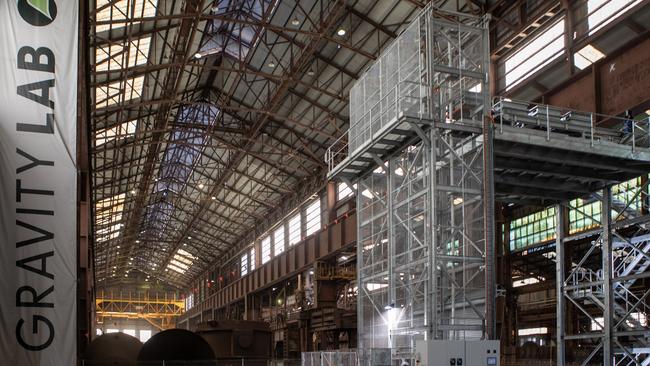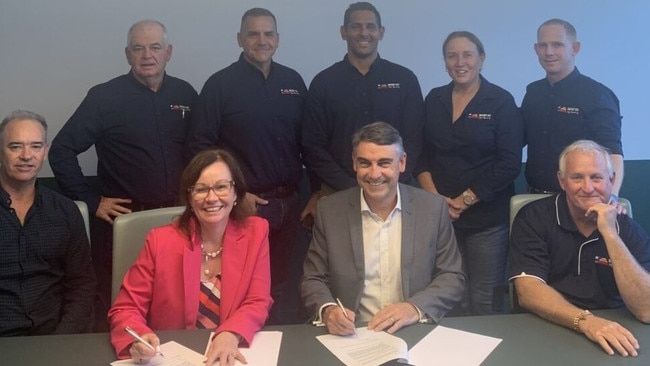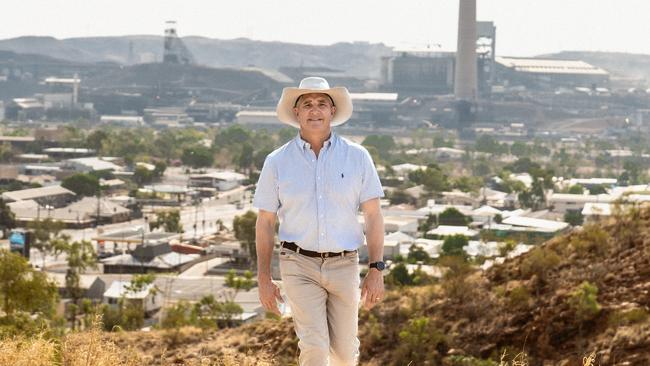How North Queensland’s deep mine shafts could be used for energy generation
Disused mine shafts in outback Queensland could soon become a green energy hub, creating jobs and using heavy weights to generate renewable power through gravity. See how.

News
Don't miss out on the headlines from News. Followed categories will be added to My News.
Kilometre-deep mine shafts in the Mount Isa region are being considered a potential asset in the race for green energy development through a weight system that harnesses gravity and solar.
Glencore plans to close its underground copper operations in Mount Isa, which it considers unviable, by mid-next year, which will impact 1200 jobs and the regional economy, but its abandoned shafts could be used for renewable energy.
Green Gravity chief executive Mark Swinnerton described the technology as a “bit like pumped hydro electricity” without water and said that up to 350 jobs could be created in Mount Isa across three stages of construction, energy generation, and manufacturing.
Mr Swinnerton said the project had the potential to be worth $1bn in storage and generation assets but that the company was still studying the feasibility, which would also include a workforce that had the potential to be re-skilled from copper mining.
“In principle, what we do is bring mass upwards, we lift mass up when we’ve got excess renewables in the middle of the day, for example, and then we lower the mass back down again when we need to regenerate the electricity to the grid,” Mr Swinnerton said.

“We’re able to turn solar into a 24/7 resource using this, and using the natural mine shafts in Isa, and so what that looks like from an engineering perspective, we use a mine winding unit, we use a regenerative electrical motor … and what we do is we have hundreds of very heavy objects.
“And we’re able to generate quite large amounts of energy because, of course, we use very large masses, and these mine shafts are really deep, so mass times height is how much energy you get.
“And that’s what makes Mount Isa really attractive, is that they’re big, wide, deep mine shafts, so we’re able to generate lots of energy.”

The company is constructing a final demonstration production system in a NSW mine shaft, which would be commissioned next year, and it would like to make its investment decisions for Mount Isa in 2026.
The Queensland Department of Resources lists 120 complex abandoned mine sites in the state, and Green Gravity considered how it might be able to transform these into investment potential.
“They’re closing all the time, everyone sees them as a liability, they’re a problem … there’s 1000s in Australia.
“And so, like, how could we turn that to view them as an asset, what is it that they’ve got that’s good, not everything is bad, surely?
“And the thing they have is great height, and that was what led to this technology.”
The Mount Isa Mayor Peta MacRae is keen to see progress on the scheme as a way to diversify the economy and to generate jobs as Glencore’s Mount Isa Copper Operations closes within the next year, and is doing whatever she can to inject positivity for the mining city, known recently for the closures, crime concerns, and its rodeo’s voluntary administration.
Her council has shown support for the project through a Memorandum of Understanding.
Most recently, the Mount Isa City Council made headlines for signing another MOU with French-Canadian company Flying Whales to develop an airship base in the city, which aims to run on hydrogen.

Ms McRae said the energy proposal aimed at developing a value chain which included the manufacture of weights needed for the generation, and the intention was that recycled metals and plastics could be used from its Materials Recovery Facility.
“Everyone’s committed to it, and it’s going well at this stage,” Ms MacRae said.
“At Glencore at the moment, the underground copper mine, there’s 16 different shafts, so some of them are like the shafts you go up and down, and some of them are ventilation shafts.
“So I think they’ve identified two they’re working on at the moment, like doing the engineering work with them to see the viability.”
Glencore’s operational plans and its support would be important to the feasibility of the project because if the mining giant decided to transition into an open-cut project, the existing shaft infrastructure would be an obstruction.
“And I guess the good thing about Green Gravity is no one actually needs to go down the shafts once it’s set up for that; the shafts are completely people-free, they seal them off, and then they just have the weights going up and down,” Ms MacRae said.
Newly re-elected Traeger MP Robbie Katter, who has used proposed legislation to pressure Glencore to keep its local mines open, had mixed views about the proposal, which he said would be used more for battery storage.
Mr Katter did not support looming emissions targets mandated by the two major parties, but he agreed in using the technology as “part of the mix” of future energy generation as a way to make energy supply more competitive.
He did not want to see the copper mines closing and believed they were still viable, but perhaps not to the profit expectations of an international investment giant.
“It would appear on the surface to be a pretty good idea,” Mr Katter said about the energy project.
“I need to qualify this by saying that is making the critical assumption that all this … doesn’t rely on the shutdown of the copper mine.
“For me, this is all predicated on the fact that you can run it while still maintaining the underground copper operations, and I’ve been told that’s possible.”
The city is a hub of production through Incitec Pivot’s acid plant and Glencore’s copper smelter, as well as regional mines, and the council and its MP Robbie Katter are aware these industries would be impacted by looming zero emissions targets.
The council is looking to tackle such emissions targets in the months to come.
More Coverage
Originally published as How North Queensland’s deep mine shafts could be used for energy generation





